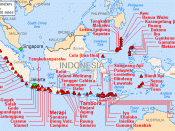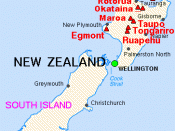What exactly is a volcano? A volcano is "A vent in the surface of the Earth through which magma and associated gases and ash erupt; also, the form or structure (usually conical) that is produced by the ejected material". Trough many discussions on volcanoes in class I decided it's not really as simple as a definition. The reason is because the science and history of volcanoes is much more complex. People like to describe volcanism in terms of an eruption and its results. There is much more needed to know in order to truly understand the complexity of volcanoes. Volcanoes play an integral role in the earth's history.
Volcanoes can be found where the earth's crust grows thin or places far away from plate boundaries called "hot spots". Volcanoes are typically found where tectonic plates converge or diverge. The moving plates cause swelling in the earth's crust. A few good places to find convergent plates are Mount Vesuvius, Mount Etna, and the Pacific Ring of Fire.
Plates underneath these mountains are stacked on top of each other causing the crust to swell. The force and friction of the 2 moving plates causes magma to erupt forming a volcano. This type of converging cause some of the worlds largest volcanoes to form, Mt. Etna being the worlds largest.
Divergent boundaries are formed when to plates spread apart from each other and the friction causes molten hot lava to form new volcanoes. A large example of this would be the Mid-Atlantic Ridge. These underwater mountain ranges are found in the Atlantic and Artic oceans. This is how many islands are formed all over the world. This divergent boundary was first formed in the Triassic period when a series of grabens collided with the super continent Pangaea. A graben is a small valley...



Teecie
Well written, informative keeps your attention.
0 out of 0 people found this comment useful.